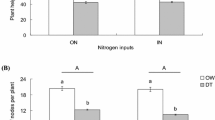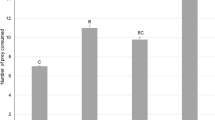Abstract
Omnivorous predatory Heteroptera are important biological control agents of pests in several crops. They can feed on plant food resources that may positively affect their biological characteristics. In the current paper, the influence of leaves and flowers on the predation rate of the omnivorous predator Macrolophus pygmaeus (Rambur) (Hemiptera: Miridae) was investigated. Its predation rates were recorded on prey offered on (a) a single leaf of tomato, pepper or black nightshade (Solanum nigrum), or (b) a leaf of pepper or S. nigrum plus flowers of pepper or S. nigrum, respectively. In all cases the aphid Myzus persicae (Sulzer) (Homoptera: Aphididae) was used as prey at densities of 4, 8, 12, 16, 20 and 24 nymphs of the second instar. The experiments were conducted in petri dishes at 25 ± 1°C and prey consumption was evaluated after 24 h. The predation rate of M. pygmaeus was significantly higher on leaves of S. nigrum than on those of pepper at the prey density of 20 prey items. Therefore, the hypothesis that increased predation rates should occur on plants of lower suitability for development or reproduction was not supported under our experimental conditions. The flower availability did not alter the prey consumption among the prey densities on S. nigrum. However, the presence of a pepper flower caused a significant decrease in the predation rates on pepper leaves, at prey densities higher than eight prey items. Thus, pepper flowers can provide the predator with nutrient sources that may partially substitute for prey consumption, with practical implications in biological control.


Similar content being viewed by others
References
Agrawal, A. A., & Klein, C. N. (2000). What omnivores eat: direct effects of induced plant resistance on herbivores and indirect consequences for diet selection by omnivores. Journal of Animal Ecology, 69, 525–535.
Agrawal, A. A., Kobayashi, C., & Thaler, J. S. (1999). Influence of prey availability and induced host plant resistance on omnivory by western flower thrips. Ecology, 80, 518–523.
Arnó, J., Sorribas, R., Prat, M., Matas, M., Pozo, C., Rodríguez, D., et al. (2009). Tuta absoluta, a new pest in IPM tomatoes in the northeast of Spain. IOBC/WPRS Bulletin, 49, 203–208.
Badii, M. H., Hernandez-Ortiz, E., Flores, A. E., & Landeros, J. (2004). Prey stage preference and functional response of Euseius hibisci to Tetranychus urticae (Acari: Phytoseiidae, Tetranychidae). Experimental and Applied Acarology, 34, 263–273.
Braman, S. K., & Beshear, R. J. (1994). Seasonality of predaceous plant bugs (Heteroptera, Miridae) and phytophagous thrips (Thysanoptera, Thripidae) as influenced by host-plant phenology of native azaleas (Ericales, Ericaceae). Environmental Entomology, 23, 712–718.
Castañé, C., Alomar, O., Riudavets, J., & Gemeno, C. (2006). Reproductive traits of the generalist predator Macrolophus caliginosus. IOBC/WPRS Bulletin, 29, 229–234.
Castañé, C., Arnó, J., Gabarra, R., & Alomar, O. (2011). Plant damage to vegetable crops by zoophytophagous mirid predators. Biological Control, 59, 22–29.
Coll, M., & Guershon, M. (2002). Omnivory in terrestrial arthropods: mixing plant and prey diets. Annual Review of Entomology, 47, 267–297.
Coll, M., & Ridgway, R. L. (1995). Functional and numerical responses of Orius insidiosus (Heteroptera: Anthocoridae) to its prey in different vegetable crops. Annals of the Entomological Society of America, 88, 732–738.
De Clercq, P., Mohaghegh, J., & Tirry, L. (2000). Effect of host plant on the functional response of the predator Podisus nigrispinus (Heteroptera: Pentatomidae). Biological Control, 18, 65–70.
Eubanks, M. D., & Denno, R. F. (2000). Host plants mediate omnivore-herbivore interactions and influence prey suppression. Ecology, 81, 936–947.
Eubanks, M. D., & Styrsky, J. D. (2005). Effects of plant feeding on the performance of omnivorous “predators”. In: F. L. Wäckers, P. C. J. van Rijn & J. Bruin (Eds.) Plant-provided food and herbivore–carnivore interactions (pp. 148–177). Cambridge, UK: Cambridge University Press.
Fantinou, A., Perdikis, D., & Maselou, D. (2008). Prey killing without consumption: does predator show adaptive foraging behavior? Biological Control, 47, 187–193.
Francis, F., Lognay, G., Wathelet, J. P., & Haubruge, E. (2001). Effects of allelochemicals from first (Brassicaceae) and second (Myzus persicae and Brevicoryne brassicae) trophic levels on Adalia bipunctata. Journal of Chemical Ecology, 27, 243–256.
Hazzard, R. V., & Ferro, D. N. (1991). Feeding responses of adult Coleomegilla maculata (Coleoptera, Coccinellidae) to eggs of Colorado potato beetle (Coleoptera, Chrysomelidae) and green peach aphids (Homoptera, Aphididae). Environmental Entomology, 20, 644–651.
Hoddle, M. S. (2003). The effect of prey species and environmental complexity on the functional response of Franklinothrips orizabensis: a test of the fractal foraging model. Ecological Entomology, 28, 309–318.
Holt, R. D., & Lawton, J. H. (1994). The ecological consequences of shared natural enemies. Annual Review of Ecology and Systematics, 25, 495–520.
Janssen, A., Willemse, E., & van der Hammen, T. (2003). Poor host plant quality causes omnivore to consume predator eggs. Journal of Animal Ecology, 72, 478–483.
Karapanos, I. C., Mahmood, S., & Thanopoulos, C. (2009). Fruit set in solanaceous vegetable crops as affected by floral and environmental factors. The European Journal of Plant Science & Biotechnology, 2(Special Issue 1), 45–61.
Lundgren, J. G. (2009). Relationships of natural enemies and non-prey foods. Dordrecht: Springer International.
Lundgren, J., Huber, A., & Wiedenmann, R. N. (2005). Quantification of consumption of corn pollen by the predator Coleomegilla maculata (Coleoptera: Coccinellidae) during anthesis in an Illinois corn field. Agricultural & Forest Entomology, 7, 53–60.
Lykouressis, D., Giatropoulos, A., Perdikis, D., & Favas, C. (2008). Assessing the suitability of non-cultivated plants and associated insect prey as food sources for the omnivorous predator Macrolophus pygmaeus (Hemiptera: Miridae). Biological Control, 44, 142–148.
Madadi, H., Enkegaard, A., Brodsgaard, H. F., Kharrazi-Pakdel, A., Mohaghegh, J., & Ashouri, A. (2007). Host plant effects on the functional response of Neoseiulus cucumeris to onion thrips larvae. Journal of Applied Entomology, 131, 728–733.
Magalhães, S., Janssen, A., Montserrat, M., & Sabelis, M. W. (2005). Host-plant species modifies the diet of an omnivore feeding on three trophic levels. Oikos, 111, 47–56.
Maleki, F., Ashouri, A., Mohaghegh, J., & Bandani, A. (2006). Effects of some diets on Macrolophus pygmaeus Rambur (Hemiptera: Miridae) fitness under laboratory conditions. Communications in Applied Biological Sciences Ghent University, 71, 393–397.
Nomikou, M., Sabelis, M. W., & Janssen, A. (2010). Pollen subsidies promote whitefly control through the numerical response of predatory mites. Biocontrol, 55, 253–260.
Perdikis, D., Kapaxidi, E., & Papadoulis, G. (2008). Biological control of insect and mite pests in greenhouse solanaceous crops. In H. Passam (Ed.) The fruiting species of the Solanaceae. The European Journal of Plant Science and Biotechnology, 2(Special Issue 1), 125–144.
Perdikis, D., & Lykouressis, D. (2000). Effects of various items, host plants and temperatures on the development and survival of Macrolophus pygmaeus Rambur (Hemiptera: Miridae). Biological Control, 17, 55–60.
Perdikis, D., & Lykouressis, D. (2004a). Macrolophus pygmaeus (Hemiptera: Miridae) population parameters and biological characteristics when feeding on eggplant and tomato without prey. Journal of Economic Entomology, 97, 1291–1298.
Perdikis, D. C., & Lykouressis, D. P. (2004b). Myzus persicae (Homoptera: Aphididae) as a suitable prey for Macrolophus pygmaeus (Hemiptera: Miridae) population increase on pepper plant. Environmental Entomology, 33, 499–505.
Perdikis, D. C., Lykouressis, D. P., & Economou, L. P. (1999). The influence of temperature, photoperiod and plant type on the predation rate of Macrolophus pygmaeus (Rambur) on Myzus persicae. Biocontrol, 44, 281–289.
Polis, G. A., & Strong, D. R. (1996). Food web complexity and community dynamics. American Naturalist, 147, 813–846.
Portillo, N., Alomar, O., & Wäckers, F. L. (2012). Nectarivory by the plant-tissue feeding predator Macrolophus pygmaeus Rambur (Heteroptera: Miridae): Nutritional redundancy or nutritional benefit? Journal of Insect Physiology, 58, 397–401.
Pumariño, L., Alomar, O., & Agustí, N. (2011). Development of specific ITS markers for plant DNA identification within herbivorous insects. Bulletin of Entomological Research, 101, 271–276.
Put, K., Bollens, T., Wäckers, F. L., & Pekas, A. (2012). Type and spatial distribution of food supplements impact population development and dispersal of the omnivore predator Macrolophus pygmaeus (Rambur) (Hemiptera: Miridae). Biological Control, 63, 172–180.
Robinson, K. A., Jonsson, M., Wratten, S. D., Wade, M. R., & Buckley, H. L. (2008). Implications of floral resources for predation by an omnivorous lacewing. Basic and Applied Ecology, 9, 172–181.
Roldán-Serrano, A. S., & Guerra-Sanz, J. M. (2004). Dynamics and sugar composition of sweet pepper (Capsicum annuum L.) nectar. Journal of Horticultural Science & Biotechnology, 79, 717–722.
SAS Institute. (2008). JMP version 8.0. Cary, NC, USA: SAS Institute Inc.
Urbaneja, A., Montón, H., & Mollá, O. (2009). Suitability of the tomato borer Tuta absoluta as prey for Macrolophus caliginosus and Nesidiocoris tenuis. Journal of Applied Entomology, 133, 292–296.
Vandekerkhove, B., & De Clercq, P. (2010). Pollen as an alternative or supplementary food for the mirid predator Macrolophus pygmaeus. Biological Control, 53, 238–242.
Van Lenteren, J. C. (2012). The state of commercial augmentative biological control: plenty of natural enemies but a frustrating lack of uptake. Biocontrol, 57, 1–20.
Van Rijn, P. C. J., & Sabelis, M. W. (2005). Impact of plant-provided food on herbivore–carnivore dynamics. In: F. L. Wäckers, P. C. J. van Rijn & J. Bruin (Eds.) Plant-provided food for carnivorous insects: A protective mutualism and its applications (pp. 223–266). Cambridge, UK: Cambridge University Press.
Wei, Q. C., & Walde, S. J. (1997). The functional response of Typhlodromus pyri to its prey, Panonychus ulmi: the effect of pollen. Experimental and Applied Acarology, 21, 677–684.
Author information
Authors and Affiliations
Corresponding author
Rights and permissions
About this article
Cite this article
Lykouressis, D., Perdikis, D. & Charalampous, P. Plant food effects on prey consumption by the omnivorous predator Macrolophus pygmaeus . Phytoparasitica 42, 303–309 (2014). https://doi.org/10.1007/s12600-013-0360-7
Received:
Accepted:
Published:
Issue Date:
DOI: https://doi.org/10.1007/s12600-013-0360-7




